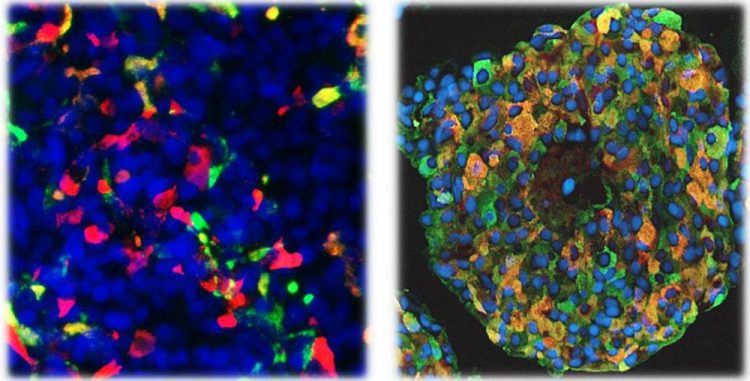Premature cell differentiation leads to disorders in pancreatic development

In the photo on the left, the cells are in middle of the differentiation process (red is insulin, green glucagon, blue DNA). In the photo on the right, the cells have nearly completed their differentiation and are grouped together in clumps of cells similar to pancreatic islets (red is insulin, green chromogranin and blue DNA). Credit: Otonkoski Lab / University of Helsinki
Neonatal diabetes mellitus (NDM), or diabetes among infants less than six months of age, is a rare form of diabetes caused by a mutation in genes crusial to the development or function of beta cells. In about half of such cases, the disease becomes permanent (PNDM). Mutations in more than 20 genes have thus far been identified as causing the permanent variety of neonatal diabetes.
Unlike in type 1 diabetes, NDM patients typically do not have the autoantibodies normally associated with diabetes. However, it was recently discovered that mutations which activate the STAT3 gene may result in neonatal diabetes that includes a strong autoimmune phenomenon.
The mutation that activated the STAT gene most intensely (K392R) was found to cause the most severe form of neonatal diabetes. The mutation was discovered in 2014 in a Finnish patient, who had high levels of beta cell antibodies at birth and underdeveloped pancreas. The patient later developed several autoimmune manifestations in different organs.
A new study, led by Professor Timo Otonkoski, examined the impact the STAT3 mutation has on the development of the pancreas by using induced pluripotent stem cells (iPS) derived from the patient's skin cells. The study was published in Cell Reports.
The iPS cells produced from the skin cells were made to differentiate into pancreatic islet cells through a complex in vitro method that mirrors the normal development of the pancreas in humans. Before differentiation, the point mutation in the patient cells was repaired using CRISPR-CAS9 genome editing. After this, it was possible to compare the differentiation of the patient's cells during pancreatic development in two kinds of genetically similar cells: ones sick carrying the disease mutation and ones made healthy after being repaired through genome editing.
The results showed that the mutated STAT3 protein produced by the patient's cells led to the premature differentiation of the pancreatic progenitor cells into endocrine cells that produce insulin or glucagon. The results were clearly apparent in both cell cultures and in cells transplanted to mice, which allowed the researchers to study the development of the cells for much longer.
“The impact of the mutated STAT3 protein mechanism we discovered accounts for the underdeveloped pancreas and the early onset of diabetes, even without the damage done by autoimmune mechanisms,” states Jonna Saarimäki-Vire, postdoctoral researcher and first author of the article.
Professor Otonkoski and researcher Diego Balboa, who was in charge of genome editing, point out that even though the mutation is rare, the study has broader impact.
“These results reveal the previously unknown significance of the STAT3 gene to pancreatic development. We also successfully used new stem cell technologies and genome editing methods that enable high-precision analysis of the mechanisms underlying disease mutations. We intend to use the same approach to study other diabetes genes in the future.”
Media Contact
All latest news from the category: Life Sciences and Chemistry
Articles and reports from the Life Sciences and chemistry area deal with applied and basic research into modern biology, chemistry and human medicine.
Valuable information can be found on a range of life sciences fields including bacteriology, biochemistry, bionics, bioinformatics, biophysics, biotechnology, genetics, geobotany, human biology, marine biology, microbiology, molecular biology, cellular biology, zoology, bioinorganic chemistry, microchemistry and environmental chemistry.
Newest articles

An Endless Loop: How Some Bacteria Evolve Along With the Seasons
The longest natural metagenome time series ever collected, with microbes, reveals a startling evolutionary pattern on repeat. A Microbial “Groundhog Year” in Lake Mendota Like Bill Murray in the movie…

Witness Groundbreaking Research on Achilles Tendon Recovery
Achilles tendon injuries are common but challenging to monitor during recovery due to the limitations of current imaging techniques. Researchers, led by Associate Professor Zeng Nan from the International Graduate…

Why Prevention Is Better Than Cure—A Novel Approach to Infectious Disease Outbreaks
Researchers have come up with a new way to identify more infectious variants of viruses or bacteria that start spreading in humans – including those causing flu, COVID, whooping cough…



